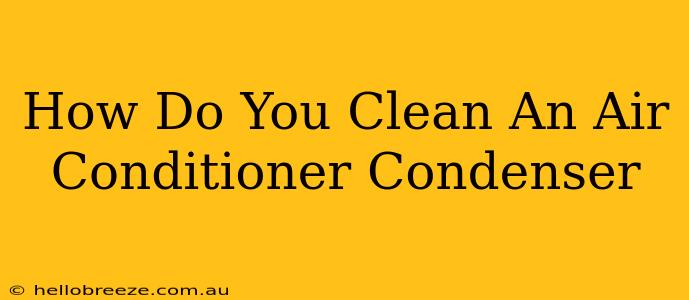Keeping your air conditioner running efficiently and effectively is crucial, especially during those sweltering summer months. A significant factor in its performance is the cleanliness of its condenser coil. A dirty condenser restricts airflow, forcing your AC to work harder, consuming more energy and potentially leading to premature failure. This comprehensive guide will walk you through how to clean your air conditioner condenser safely and effectively.
Why Clean Your AC Condenser?
Before diving into the cleaning process, let's understand why it's so important. A clogged condenser coil is a breeding ground for:
- Reduced Efficiency: Dust, dirt, leaves, and other debris impede airflow, making the unit struggle to cool your home. This leads to higher energy bills and potentially shorter lifespan.
- Increased Energy Consumption: A struggling AC unit will draw more power, significantly impacting your electricity costs.
- Potential for Damage: Overworking the system due to restricted airflow can lead to compressor failure and other costly repairs.
- Frozen Coils: In some cases, restricted airflow can lead to ice formation on the evaporator coil, further hindering the cooling process.
Cleaning your condenser coil regularly can prevent all of these problems.
Tools and Materials You'll Need
Before you begin, gather the necessary supplies:
- Garden Hose with a Spray Nozzle: A strong spray is essential for dislodging dirt and debris.
- Fin Comb (Optional but Recommended): This tool gently straightens bent condenser fins, improving airflow.
- Vacuum Cleaner with a Brush Attachment (Optional): Helpful for removing loose debris before hosing.
- Safety Glasses: Protect your eyes from flying debris.
- Gloves: Protect your hands from dirt and grime.
- Drop Cloth (Optional): Protect the surrounding area from water.
- AC Coil Cleaning Spray (Optional): For a deeper clean, consider using a specialized cleaning spray. Always follow the manufacturer's instructions.
Step-by-Step Cleaning Guide
1. Safety First!
- Turn off the power: Before you begin, always switch off the power to the air conditioner at the breaker box. This prevents electrical shock.
- Allow the unit to cool: Give the condenser some time to cool down before you begin cleaning to avoid burns.
2. Prepare the Area:
- Clear the surrounding area: Remove any debris, plants, or obstacles around the condenser unit.
- Lay down a drop cloth (optional): This will prevent water from damaging surrounding areas.
3. Initial Cleaning (Optional):
- Use a vacuum: Gently vacuum the condenser coil to remove loose dirt and debris. Use the brush attachment to avoid damaging the fins.
4. Hose Down the Condenser:
- Use a gentle spray: Start by rinsing the coil with a gentle stream of water from your garden hose. Avoid using a high-pressure nozzle, as this can damage the fins.
- Work systematically: Clean the entire coil, ensuring that all areas are thoroughly rinsed. Pay particular attention to areas with heavy buildup.
- Rinse thoroughly: After cleaning, rinse the coil again with clean water to remove any remaining dirt or cleaning solution.
5. Straighten Bent Fins (Optional):
- Use a fin comb: Gently use a fin comb to straighten any bent fins. Bent fins restrict airflow, reducing efficiency. Be careful not to damage the fins further.
6. Allow to Dry:
- Let it air dry: Allow the condenser coil to air dry completely before turning the power back on.
7. Final Inspection:
- Check for debris: Inspect the unit to ensure that all debris has been removed.
Maintaining a Clean Condenser
Cleaning your AC condenser is not a one-time task. Regular maintenance is key to ensuring optimal performance and longevity. Aim to clean your condenser at least once a year, and more often if you live in a dusty or dirty environment.
Professional Help
While cleaning your condenser is a manageable DIY task, if you are uncomfortable working with electrical appliances or notice significant damage to the unit, consider calling a qualified HVAC technician. They have the expertise and tools to handle more complex issues. Regular professional maintenance is also highly recommended.
By following these steps and establishing a regular cleaning schedule, you can keep your air conditioner running smoothly and efficiently for years to come, saving you money on energy bills and avoiding costly repairs. Remember safety is paramount – always prioritize safety when working with electrical appliances.

